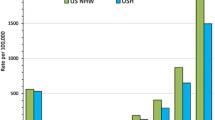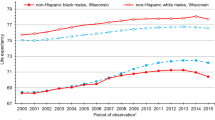Abstract
This paper examines the demographic and social factors associated with differences in length of life by race. The results demonstrate that sociodemographic factors—age, sex, marital status, family size, and income—profoundly affect black and white mortality. Indeed, the racial gap in overall mortality could close completely with increased standards of living and improved lifestyles. Moreover, examining cause-specific mortality while adjusting for social factors shows that compared to whites, blacks have a lower mortality risk from respiratory diseases, accidents. and suicide; the same risk from circulatory diseases and cancer; and higher risks from infectious diseases, homicide, and diabetes. These results underscore the importance of examining social characteristics to understand more clearly the race differences in overall and cause-specific mortality.
Similar content being viewed by others
References
Bell, Catherine A. 1991. “Female Homicides in United States Workplaces, 1980–1985.” American Journal of Public Health 81(6):729–32.
Blendon, Robert J., Linda H. Aiken, Howard E. Freeman, and Christopher R. Corey. 1989. “Access to Medical Care for Black and White Americans: A Matter of Continuing Concern.” JAMA 261(2):278–81.
Centers for Disease Control (CDC). 1990. “Black-White Differences in Cervical Cancer Mortality- United States, 1980–1987.” Morbidity and Mortality Weekly Report 39(15):245–48.
Cockerham, William C. 1988. “Medical Sociology.” Pp. 575–599 in Handbook of Sociology, edited by N. J. Smelser. Beverly Hills: Sage.
Crimmins, Eileen M. 1981. “The Changing Pattern of American Mortality Decline, 1940–77, and Its Implications for the Future.” Population and Development Review 7(2):229–54.
Dixon, Wilfrid J., Morton B. Brown, Laszlo Engelman, and Robert I. Jennrich (eds.). 1990. BMDP Statistical Software Manual, Vol 2. Berkeley: University of California Press.
Farley, Reynolds and Walter R. Allen. 1987. The Color Line and the Quality of Life in America. New York: Russell Sage Foundation.
Gove, Walter R. 1973. “Sex, Marital Status, and Mortality.” American Journal of Sociology 79(1):45–67.
Greenberg, Daniel S. 1990. “Black Health: Grim Statistics.” Lancet 335(8692):780–81.
Gulaid, Jama, E. Chukwudi Onwuachi-Saunders, Jeffrey J. Sacks, and Diane R. Roberts. 1988. “Differences in Death Rates Due to Injury among Blacks and Whites, 1984.” Morbidity and Mortality Weekly Report 37(SS-3):25–31.
Hauck, Walter W., Jr. and Allan Donner. 1977. “Wald’s Test as Applied to Hypotheses in Logit Analysis.” Journal of the American Statistical Association 72(360):851–53.
Hollingsworth, J. Rogers. 1981. “Inequality in Levels of Health in England and Wales, 1891–1971.” Journal of Health and Social Behavior 22(3):268–83.
Jaynes, Gerald D. and Robin M. Williams Jr. (eds.). 1989. A Common Destiny: Blacks and American Society. Washington, DC: National Academy Press.
Keith, Vema M. and David P. Smith. 1988. “The Current Differential in Black and White Life Expectancy.” Demography 25(4):625–32.
Kolonel, Laurence N., Tomio Hirohata, and Abraham M. Y. Nomura. 1977. “Adequacy of Survey Data from Substitute Respondents.” American Journal of Epidemiology 196:476–84.
Manton, Kenneth G., Clifford H. Patrick, and Katrina W. Johnson. 1987. “Health Differentials between Blacks and Whites: Recent Trends in Mortality and Morbidity.” The Milbank Quarterly 65(Supplement 1):129–99.
Mare, Robert D. 1990. “Socioeconomic Careers and Differential Mortality among Older Men in the United States.” pp. 362–387 in Comparative Studies of Mortality and Morbidity: Old and New Approaches to Measurement and Analysis, edited by J. Vallin, A. Palloni, and S. D’Souza. London: Oxford University Press.
Marmot, M. G., M. Kogevinas, and M. A. Elston. 1987. “Social/Economic Status and Disease.” Annual Review of Public Health 8:111–35.
Marshall, James, Rogers Priore, Brenda Haughey, Thomas Rzepka, and Saxon Graham. 1980. “Spouse-Subject Interviews and Reliability of Diet Studies.” American Journal of Epidemiology 112:675–83.
Mergenhagen, Paula M., Barrett A. Lee, and Walter R. Gove. 1985. “Till Death Do Us Part: Recent Changes in the Relationship between Marital Status and Mortality.” Sociology and Social Research 70(1):53–56.
Mott, Frank L. and R. Jean Haurin. 1985. “Factors Affecting Mortality in the Years Surrounding Retirement.” Pp, 31–56 in Retirement among American Men, edited by H. S. Parnes, J. E. Crowley, R. J. Haurin, L. J. Less, W. R. Morgan, F. L. Mott, and G. Nestel. Lexington, MA: Lexington Books.
Mutchler, Jan E. and Jeffrey A. Burr. 1991. “A Longitudinal Analysis of Household and Nonhousehold Living Arrangements in Later Life.” Demography 28(3):375–90.
Nam, Charles B. and George C. Myers. 1987. “Introduction: An Overview of Mortality Patterns and Their Policy Implications.” Population Research and Policy Review 6(2):97–104.
Nam, Charles B., Norman L. Weatherby, and Kathleen A. Ockay. 1978. “Causes of Death Which Contribute to the Mortality Crossover Effect.” Social Biology 25(4):306–14.
National Center for Health Statistics (NCHS). 1980. Data Systems of the National Center for Health Statistics. DHEW Publication (PHS) 80–1247. Hyattsville, MD: United States Government Printing Office.
— 1985. U.S. Decennial Life Tables for 1979–81, Vol. 1, No.1. DHHS Publication (PHS) 85-1150-1. Washington, DC: United States Government Printing Office.
— 1988a. National Mortality Followback Survey, 1986. Public Use Data Tape and Documentation. Hyattsville, MD: United States Department of Health and Human Services.
— 1988b. Vital Statistics of the United States, 1986. Vol. II: Mortality, Part A. DHHS Publication (PHS) 88–1122. Washington, DC: United States Government Printing Office.
— 1989. National Health Interview Survey, 1986 (computer file). 2nd ed. Washington, DC: United States Department of Health and Human Services (producer). Ann Arbor: Inter-University Consortium for Political and Social Research (distributor).
— 1990. “Advance Report of Final Mortality Statistics, 1988.” Monthly Vital Statistics Report 39(7) supp. Hyattsville, MD: U.S. Public Health Service.
— 1991a. “Annual Summary of Births, Marriages, Divorces, and Deaths: United States, 1990.” Monthly Vital Statistics Report 39(13). Hyattsville, MD: U.S. Public Health Service.
— 1991b. Health, United States, 1990. Hyattsville, MD: United States Government Printing Office.
— 1991c. Vital Statistics of the United States, 1988: Life Tables. Vol II, Sec 6. Washington, DC: United States Government Printing Office.
Navarro, Vicente. 1990. “Race or Class versus Race and Class: Mortality Differentials in the United States.” Lancet 336:1238–40.
Otten, Mac W., Jr., Steven M. Teutsch, David F. Williamson, and James S. Marks. 1990. “The Effect of Known Risk Factors on the Excess Mortality of Black Adults in the United States.” Journal of American Medical Association 263(6):845–50.
Poe, Gail S., Isadore Seeman, Joseph McLaughlin, Eric Mehl, and Michael Dietz. 1988. “Don’t Know Boxes in Factual Questions in a Mail Questionnaire: Effects of Level and Quality of Response.” Public Opinion Quarterly 52(2):212–22.
Potter, Lloyd B. 1991. “Socioeconomic Determinants of White and Black Males’ Life Expectancy Differentials, 1980.” Demography 28(2):303–21.
Riley, Matilda White. 1990. “Aging in the Twenty-First Century.” Boettner Lecture. Bryn Mawr: Boettner Research Institute.
Rogers, Richard G. 1991. “Marital Status and Mortality.” pp. 1–30 in Population Program Working Paper WP-91-2. Boulder: University of Colorado.
Rogers, Richard G. and R. Hackenberg. 1987. “Extending Epidemiologic Transition Theory: A New Stage.” Social Biology 34(3–4):234–43.
Rosenwaike, Ira and Barbara Logue. 1983. “Accuracy of Death Certificate Ages for the Extreme Aged.” Demography 20(4):569–85.
Seeman, Isadore, Gail S. Poe, and Joseph K. McLaughlin. 1989. “Design of the 1986 National Mortality Followback Survey: Considerations on Collecting Data on Decedents.” Public Health Reports 104(2):183–88.
Shryock, Henry S., Jacob S. Siegel, and associates. 1976. The Methods and Materials of Demography. New York: Academic Press.
Smith, David P. 1988. User’s Guide for Program SURVNAL. Houston: University of Texas School of Public Health.
Smock, Pamela J. 1990. “Remarriage Patterns of Black and White Women: Reassessing the Role of Educational Attainment.” Demography 27(3):467–73.
Susser, Mervyn W., William Watson, and Kim Hopper. 1985. Sociology in Medicine. New York: Oxford University Press.
U.S. Bureau of the Census. 1991. The Black Population in the United States: March 1990 and 1989. Current Population Reports, Series P-20, No. 448. Washington, DC: United States Government Printing Office.
U.S. Department of Health and Human Services (DHHS). 1985. Report of the Secretary’s Task Force on Black & Minority Health, Vol. I: Executive Summary. Washington, DC: United States Government Printing Office.
— 1989a. International Classification of Diseases, Vol. 1, 9th rev., 3rd ed. DHHS Publication (PHS) 89–1260. Washington, DC: United States Government Printing Office.
— 1989b. Promoting Health/Preventing Disease: Year 2000 Objectives for the Nation (Draft). Washington, DC: United States Government Printing Office.
Wilson, William J. 1987. The Truly Disadvantaged: The Inner City, the Underclass, and Public Policy. Chicago: University of Chicago Press.
Wing, Steve, Kenneth G. Manton, Eric Stallard, Curtis G. Hames, and H. A. Tryoler. 1985. “The BlacklWhite Mortality Crossover: Investigation in a Community-Based Study.” Journal of Gerontology 40(1):78–84.
Wolinsky, Fredric D. and Robert J. Johnson. 1991. “The Use of Health Services by Older Adults.” Journals of Gerontology. 46(6):S345–57.
Zick, Cathleen D. and Ken R. Smith. 1991. “Marital Transitions, Poverty, and Gender Differences in Mortality.” Journal of Marriage and the Family 53:327–36.
Author information
Authors and Affiliations
Additional information
The 1986 National Health Interview Survey (NHIS) data set employed in this article was made available in part by the Inter-University Consortium for Political and Social Research. The data for the 1986 NHIS were originally collected by the U.S. Department of Health and Human Services and by the National Center for Health Statistics. I thank Eve Powell-Griner, Harriet Orcutt Duleep, Kenneth C. Land, Robert McNown, Thomas Pullum, the editor of Demography, and the anonymous reviewers for their insightful comments and suggestions. Neither the collector of the original data nor the Consortium bears responsibility for the analysis or interpretations presented here. An earlier draft of this paper was presented at the annual meetings of the Population Association of America held March 21–23, 1991 in Washington, DC.
Rights and permissions
About this article
Cite this article
Rogers, R.G. Living and dying in the U.S.A.: Sociodemographic determinants of death among blacks and whites. Demography 29, 287–303 (1992). https://doi.org/10.2307/2061732
Issue Date:
DOI: https://doi.org/10.2307/2061732




